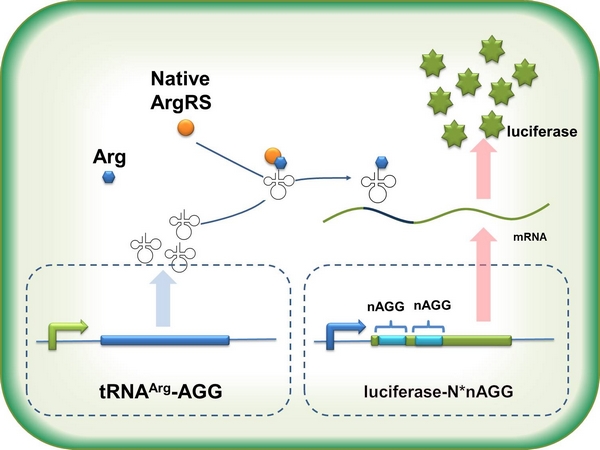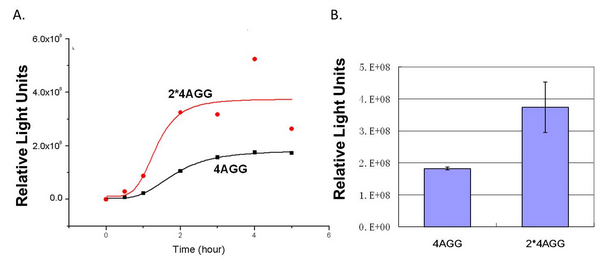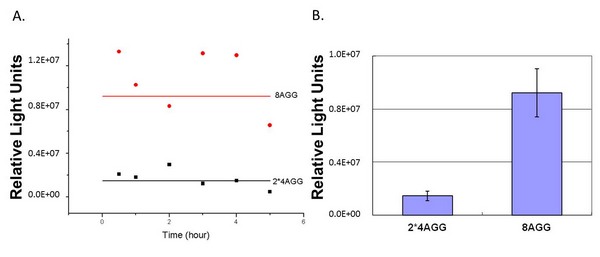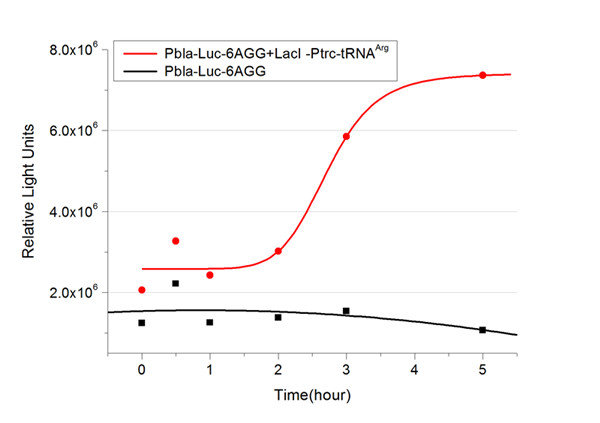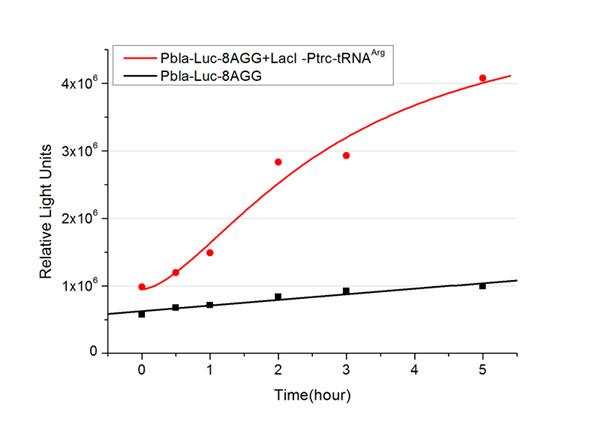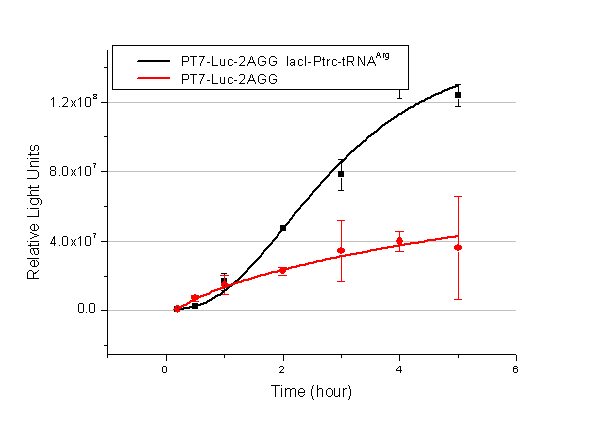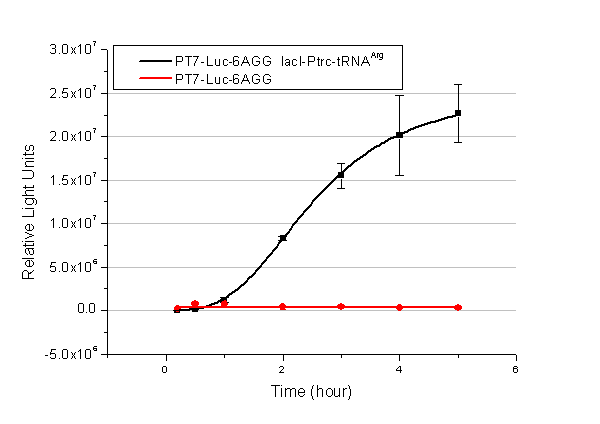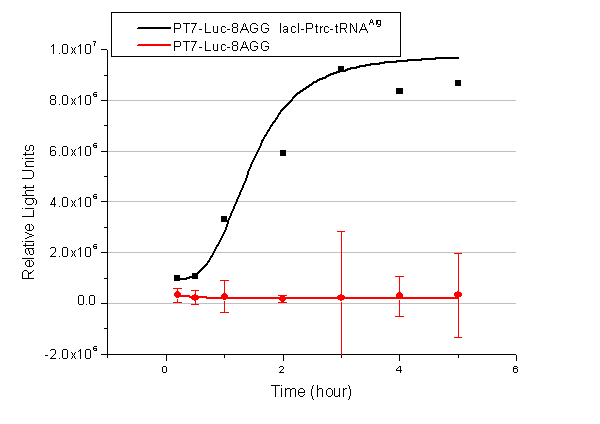|
Number of Rare Codons
In this part we want to explore the influence of the number of rare codons inserted in the mRNA. We have inserted 2, 4, 6, 8 AGG codons respectively after the start codon in luciferase gene. T7 promoter or bla promoter[1] are used to control target protein mRNA amount. We use different combinations of number of AGG codons and strength of promoters to characterize regulation[1].
1) bla promoter-luciferase (weaker promoter)
A tandem of 2, 4, 6 or 8 AGG codons is inserted after the ATG codon of wild type luciferase
Parts:
- Pbla-Luc-2AGG([http://partsregistry.org/wiki/index.php?title=Part:BBa_K567004 BBa_K567004])
- Pbla-Luc-4AGG([http://partsregistry.org/wiki/index.php?title=Part:BBa_K567005 BBa_K567005])
- Pbla-Luc-6AGG([http://partsregistry.org/wiki/index.php?title=Part:BBa_K567006 BBa_K567006])
- Pbla-Luc-8AGG([http://partsregistry.org/wiki/index.php?title=Part:BBa_K567007 BBa_K567007])
2) T7 promoter-luciferase (stronger promoter)
A tandem of 2, 4, 6 or 8 AGG codons is inserted after the ATG codon of wild type luciferase
Parts:
- PT7-Luc-2AGG([http://partsregistry.org/wiki/index.php?title=Part:BBa_K567008 BBa_K567008])
- PT7-Luc-4AGG([http://partsregistry.org/wiki/index.php?title=Part:BBa_K567009 BBa_K567009])
- PT7-Luc-6AGG([http://partsregistry.org/wiki/index.php?title=Part:BBa_K567019 BBa_K567019])
- PT7-Luc-8AGG([http://partsregistry.org/wiki/index.php?title=Part:BBa_K567010 BBa_K567010])
Influence of inserted AGG codon number
The influence of different number of rare codons in regulating protein biosynthesis is shown below:
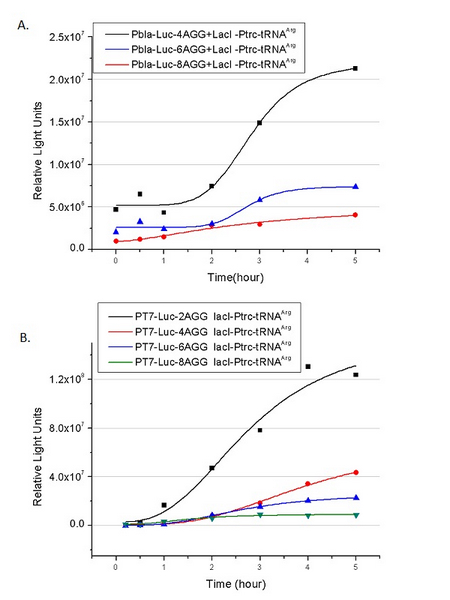 Fig.1 (A) Comparing the influence of different number of rare codon insertions in luciferase production. Pbla-Luc-4AGG ([http://partsregistry.org/wiki/index.php?title=Part:BBa_K567005 BBa_K567005]), Pbla-Luc-6AGG ([http://partsregistry.org/wiki/index.php?title=Part:BBa_K567006 BBa_K567006]) and Pbla-Luc-8AGG ([http://partsregistry.org/wiki/index.php?title=Part:BBa_K567007 BBa_K567007]). (B) Comparing the influence of different number of rare codon insertions in luciferase production. Four Reporters are examined, including PT7-Luc-2AGG([http://partsregistry.org/wiki/index.php?title=Part:BBa_K567008 BBa_K567008]), PT7-Luc-4AGG([http://partsregistry.org/wiki/index.php?title=Part:BBa_K567009 BBa_K567009]), PT7-Luc-8AGG ([http://partsregistry.org/wiki/index.php?title=Part:BBa_K567010 BBa_K567010]) and PT7-Luc-6AGG ([http://partsregistry.org/wiki/index.php?title=Part:BBa_K567019 BBa_K567019]).
This picture reflects more clearly that the more rare codons are inserted, the lower the background expression and the narrower the range of device regulation. We are able to predict the outcome of influence of different number of rare codons in protein biosynthesis, offering valuable information for device usage.
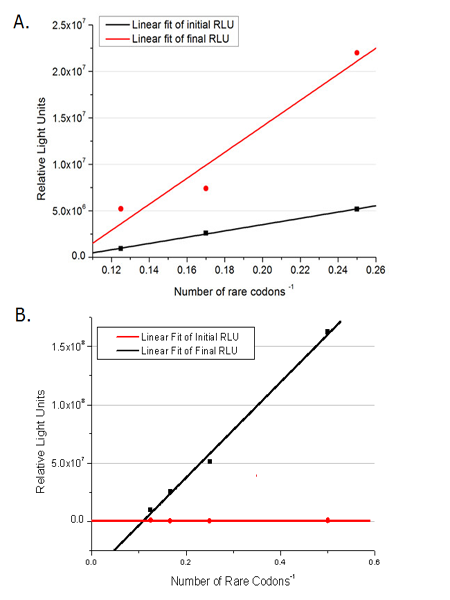 Fig.2 The comparison between background expression and induced expression of luciferase with different rare codon insertions. (A)PT7-luc reporters. (B) Pbla-luc reporters Influence of different strengths of target protein promoters
We examined the influence of different Reporter promoters on the working curve of our device, which is reflected by luciferase activity. The working range of our device is pre-defined by the strength of target protein promoter, T7 promoter and bla promoter in our project.
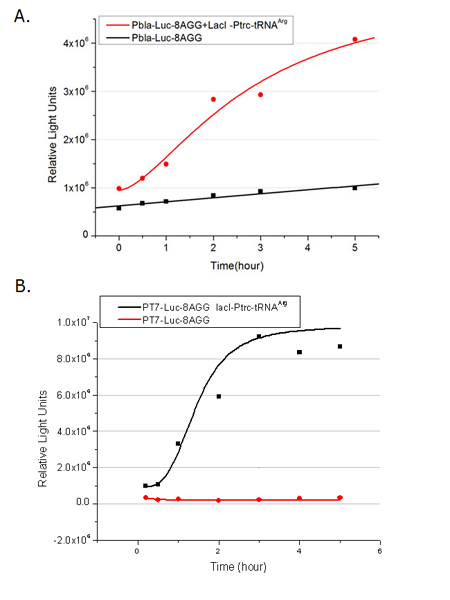 Fig.3 (A) Luciferase (Pbla-Luc-8AGG) production in cells overexpressing rare tRNA with lacI-Ptrc-tRNAArg. Luciferase production is reflected by bioluminescence emitted from the luciferin reaction. (B) Luciferase production in cells with PT7-Luc-8AGG as reporter. Here we analyze the influences of strong/weak promoter in luciferase production. Strong promoter (T7) of target gene can improve the titration curve, indicating that our device works better under strong target protein promoters. Location of Rare Codons
We further study the influence of AGG codon in regulating protein biosynthesis when they are placed at different locations with different copy numbers. We designed three constructs to test the two influencing factors.
A tag with two-copy 4AGG insertions with an interval of 30 bp was before the luciferase gene

A tag with two-copy 4AGG insertions with an interval of 111 bp was added before the luciferase gene

A tag with three-copy 4AGG insertions with intervals of 30 bp and 111bp was added before the luciferase gene

Experiment results showed that the length of interval between the two-copy 4AGG did not affect much of the background production.
Yet, protein production can be induced to a higher level when there is a longer interval (111bp).
When there are three copies of 4AGG in the tag, background production is lowered. The yield is also lowered.
Experiment results showed that luciferase tagged with two-copy 4AGG insertions with an interval of 111 bp can increase yield and lower background noise of target protein. We further conducted experiments to test its characters.
When we compare the two-copy 4AGG tagged luciferase with the single copy one, we find that two-copy 4AGG tagged luciferase has a higher yield.
When we compare the two-copy 4AGG tagged luciferase with 8AGG tagged luciferase, we find that two-copy 4AGG tagged luciferase has a lower background.
Note: Our device can be used as a regulating tool
We have tested luciferin reaction in cells. We examined the changes in luciferase enzyme activity over time after rare tRNA expression is induced. The amount of luciferase is reflected indirectly by the bioluminescence emitted from the luciferin reaction. Results are shown below:
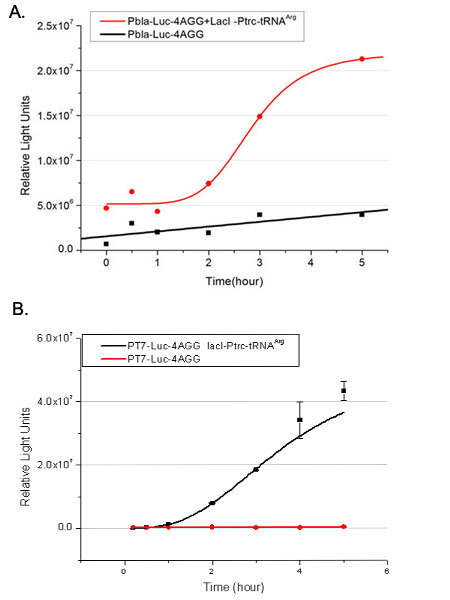 Fig.4 (A)Luciferase (Pbla-Luc-4AGG([http://partsregistry.org/wiki/index.php?title=Part:BBa_K567006 BBa_K567006])) production reflected by bioluminescence emitted from the luciferin reaction. (B)Luciferase (PT7-Luc-4AGG ([http://partsregistry.org/wiki/index.php?title=Part:BBa_K567009 BBa_K567009])) production reflected by bioluminescence emitted from the luciferin reaction. Here we use the above two curves as examples to characterize the working curve of our device. Both curves fits typical titration curve, indicating that our device can function as a regulating tool.
The rest of the working curves are shown here:
Note:Click to see large figures.
Results showed that all the devices’ working curves fit titration curve, indicating that our device can act as a satisfying regulating tool.
From this experiment, we noticed that the typical working curve of our device can be better observed under IPTG induced lacI-Ptrc-tRNAArg ([http://partsregistry.org/wiki/index.php?title=Part:BBa_K567001 BBa_K567001]) compared with UV excitation induced sulA promoter-tRNAArg([http://partsregistry.org/wiki/index.php?title=Part:BBa_K567002 BBa_K567002]), though sulA promoter-tRNAArg responded quicker to signals. So in the above experiments, we test with lacI-Ptrc-tRNAArg.
|
 "
"
